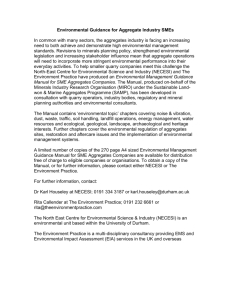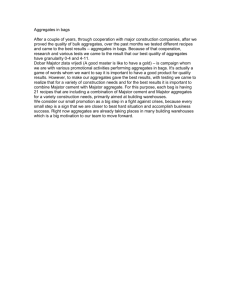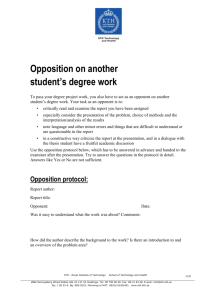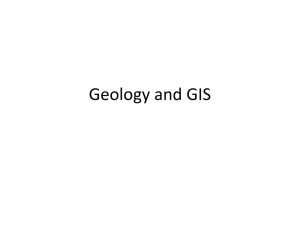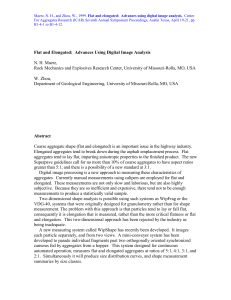Background - Mark- och vattenteknik
advertisement
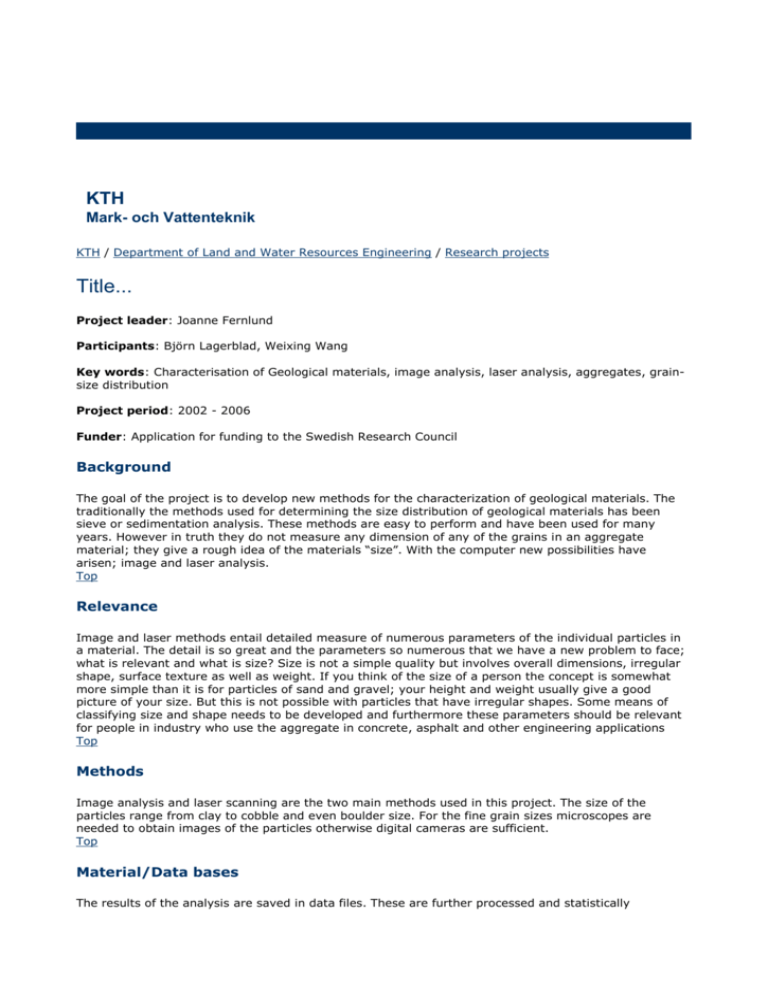
KTH Mark- och Vattenteknik KTH / Department of Land and Water Resources Engineering / Research projects Title... Project leader: Joanne Fernlund Participants: Björn Lagerblad, Weixing Wang Key words: Characterisation of Geological materials, image analysis, laser analysis, aggregates, grainsize distribution Project period: 2002 - 2006 Funder: Application for funding to the Swedish Research Council Background The goal of the project is to develop new methods for the characterization of geological materials. The traditionally the methods used for determining the size distribution of geological materials has been sieve or sedimentation analysis. These methods are easy to perform and have been used for many years. However in truth they do not measure any dimension of any of the grains in an aggregate material; they give a rough idea of the materials “size”. With the computer new possibilities have arisen; image and laser analysis. Top Relevance Image and laser methods entail detailed measure of numerous parameters of the individual particles in a material. The detail is so great and the parameters so numerous that we have a new problem to face; what is relevant and what is size? Size is not a simple quality but involves overall dimensions, irregular shape, surface texture as well as weight. If you think of the size of a person the concept is somewhat more simple than it is for particles of sand and gravel; your height and weight usually give a good picture of your size. But this is not possible with particles that have irregular shapes. Some means of classifying size and shape needs to be developed and furthermore these parameters should be relevant for people in industry who use the aggregate in concrete, asphalt and other engineering applications Top Methods Image analysis and laser scanning are the two main methods used in this project. The size of the particles range from clay to cobble and even boulder size. For the fine grain sizes microscopes are needed to obtain images of the particles otherwise digital cameras are sufficient. Top Material/Data bases The results of the analysis are saved in data files. These are further processed and statistically evaluated. Top Title... Project leader: Joanne Fernlund Participants: Lars Stenlid, Weixing Wang Key words: Characterisation of wear by LA tests on railroad aggregates using image analysis distribution Project period: 2002 - 2003 Funder: Funding not confirmed Background Wear of aggregates for railroads is often tested using a LA drum (LA stands for Los Angeles). In general aggregates are placed in a drum which is rotated for a certain number of revolutions after which the aggregates are removed and sieved. The change in size reflects some measure of their resistance to wear. This method uses sieve analysis twice: first to select the particles to be put in the drum and then to evaluate their change in size. Sieve analysis however does not really measure the size or shape of the particles, it only is an indirect measure of size. Top Relevance Image analysis is to be used to measure the size, shape and surface texture of the particles both prior to and after the LA drum test. Since image analysis can measure many parameters for each particle the actual effect of wear will be able to be studied in detail. This is very important for aggregates used in areas where wear is a prime concern such as is the case in railroad aggregates. Top Methods Image analysis and Los Angeles milling tests Top Material/Data bases The results of the analysis are saved in data files. These are further processed and statistically evaluated. Top Partners The above research projects have close contact both with Lars Stenlid at the Skanska aggregate lab in Bålsta and Per Murėn, Vice president of technology Ballast at NCC. Top Publications/Presentations This research project is still in the planning stage, funding has been applied for but not confirmed. The past research in this field has resulted in the following masters, licentiate and doctorate thesis. Passi Tolppanen, 2001, 3-D characterization and degradation analysis of rock aggregates, Doctoral Thesis, Division of Engineering Geology, Department of Civil and Environmental Engineering, Royal Institute of Technology. Anna Klingberg, 2001, Variationer hos materialparametrar inom Balastindustrin, Licentiate thesis, Division of Engineering Geology, Department of Land and Water Recourses Engineering, Royal Institute of Technology. Maria Teresa Font Jimenez, 2001, Influence of fine aggregate’s shape on mortar theology, Masters Thesis, Division of Engineering Geology, Department of Land and Water Recourses Engineering, Royal Institute of Technology. Patrick Ebeling, 2001, Characterization of aggregate degradation by 3-D laser scanning, Masters Thesis, Division of Engineering Geology, Department of Civil and Environmental Engineering, Royal Institute of Technology. Mattias Widenbrant, 2000, Sjölvkompakterande betong med bergkrossmaterial – kornformens inverkan på betongens reologi, Masters Thesis, Division of Engineering Geology, Department of Land and Water Recourses Engineering, Royal Institute of Technology. Sabina Hassenruck, 1999, Influence of aggregate shape on fresh concrete rheology, Masters Thesis, Division of Engineering Geology, Department of Land and Water Recourses Engineering, Royal Institute of Technology. Joanne Fernlund, 1988, The effect of particle form on sieve analysis, a test by image analysis, Engineering Geology 50, 111-124. Lennart Ljungström, 1998, Image analysis of road surfaces, Licentiate Thesis, Division of Engineering Geology, Department of Land and Water Recourses Engineering, Royal Institute of Technology. The picture is of railroad aggregates. Sidansvarig: Mark- och Vattenteknik, KTH, Infomaster@aom.kth.se Top The picture is of railroad aggregates. Sidansvarig: Mark- och Vattenteknik, KTH, Infomaster@aom.kth.se
